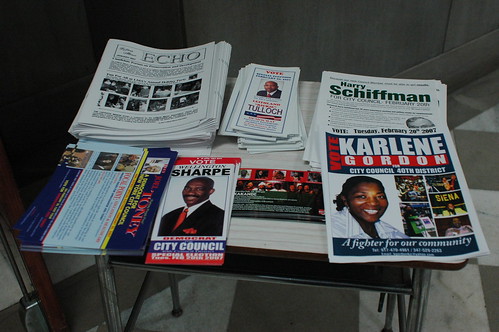[2006.08.03-11:40am EDT: See bottom of entry for link to article describing history of the Avenue H Station House.]
This post is rather lengthy. I’m hoping to make up for my numerous small and seemingly scattered, though all intricately interwoven in my mind, posts.

Google Map image of South Midwood area of Victorian Flatbush in Brooklyn. North is to the left in this image. The neighborhood is bounded by Foster Avenue (diagonal road) on the north (left), Brooklyn College (large ballfield) on the south (right), East 21st Street on the west, and Bedford Avenue on the east. South Midwood is one of about a dozen distinct neighborhoods of Victorian Flatbush.
On Sunday, July 30, I attended the South Midwood Garden Tour. I was invited by a fellow gardener from that neighborhood whose husband I had met at a “new neighbors” event last year, after we bought our house. We invited them to our house opening party last fall, and I got to sketch out the “garden in my mind” which was forming out of the weeds and dust which came with the house.

The Avenue H Subway Station, just a few blocks from the start of the tour at the community garden. This station was recently granted landmark status. At the turn of the last century, it was a real estate office for the new developments arising along the old Coney Island RR line, now the B/Q lines. It’s the only wood-frame station house in the subway system, and the only one which was not originally built for a railroad purpose.
My journey began by taking the Q train from my local station a couple of stops south to Avenue H. The tour began at 11am at a community garden, the Campus Road Garden at Brooklyn College. This is located at the western end of the Brooklyn College campus, near the ball fields.
The light towers surrounding the playing fields have large nests of Monk Parakeets. Their calls were constant. Dragonflies were swarming over and around the gardens. Butterflies were everywhere.


Campus Road Garden, looking north.

Campus Road Garden, looking west back toward Avenue H.



The house of the first garden on the tour. The garden in the backyard was lovely, but I really liked the look of these vines embracing the turret.

The backyard garden of the same house. The gardener was not available for interrogation, but the tour guide told us that everything had been designed and built over several years by the owner.

Second garden on the tour. The cool shade and sound of the waterfall was a welcome relief from the oppressive heat that day. The owner is standing with her back to the camera. This garden was just built in June of this year.
The next four photos are all from the same house and gardens. It’s on a double lot, 100ft x 100ft, a rarity in Brooklyn, but South Midwood has several of them. This garden was one of the highlights of the tour for me.




Skipping ahead a few gardens, these next two photos are different views of a well-designed and inviting accessible garden. The raised beds were customed designed and built for the gardener, whose mobility had become restricted over time. The integral seating is a terrific feature, providing both a place to sit and work the beds, and inviting visitors to get up close and personal with the plantings. This was another garden at the top of my list of favorites. I have so many ideas for my own gardens from this one.


Another backyard garden.

At this stop it was the house, and not the gardens, which was featured on the tour. But the gardens make their own statement, which I would not want you to do without.

A couple of flower portraits from two other gardens.


I have a special fondness for large, red Hibiscus. It takes me back to my childhood in space-age Florida. I picked flowers just like this from the monstrous, garage-sized shrubs outside our house to dissect, study, and learn all the parts of the flower. I even put together a presentation on flowers and pollination for my grade school classmates and school. Yes, I was a curious child, in all the meanings of the word.
At the penultimate stop, the gardener invites his guests to enjoy the sensual pleasures of his herb garden.

The last, but not least, stop on the tour, home of the tour guide. The food and refreshments were raved over. And the gardens were nothing to sneeze at, either.

Links:







































